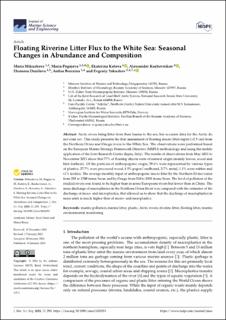| dc.contributor.author | Mikusheva, Maria | |
| dc.contributor.author | Pogojeva, Maria | |
| dc.contributor.author | Kotova, Ekaterina | |
| dc.contributor.author | Kozhevnikov, Alexsander | |
| dc.contributor.author | Danilova, Eleonora | |
| dc.contributor.author | Berezina, Anfisa | |
| dc.contributor.author | Yakushev, Evgeniy | |
| dc.date.accessioned | 2023-09-21T13:10:16Z | |
| dc.date.available | 2023-09-21T13:10:16Z | |
| dc.date.created | 2023-03-10T15:59:22Z | |
| dc.date.issued | 2023 | |
| dc.identifier.citation | Journal of Marine Science and Engineering. 2023, 11 (2), 293. | en_US |
| dc.identifier.issn | 2077-1312 | |
| dc.identifier.uri | https://hdl.handle.net/11250/3091111 | |
| dc.description.abstract | Arctic rivers bring litter from their basins to the sea, but accurate data for the Arctic do not exist yet. This study presents the first assessment of floating macro litter input (>2.5 cm) from the Northern Dvina and Onega rivers to the White Sea. The observations were performed based on the European Marine Strategy Framework Directive (MSFD) methodology and using the mobile application of the Joint Research Centre (Ispra, Italy). The results of observations from May 2021 to November 2021 show that 77% of floating objects were of natural origin (mainly leaves, wood and bird feathers). Of the particles of anthropogenic origin, 59.6% were represented by various types of plastics, 27.7% were processed wood, 8.5% paper/cardboard, 2.7% metal, 1.1% were rubber and <1% textiles. The average monthly input of anthropogenic macro litter by the Northern Dvina varies from 250 to 1700 items/hour, and by Onega from 520 to 2350 items/hour. The level of pollution of the studied rivers was found to be higher than in some Europeans rivers but lower than in China. The mass discharge of macroplastics in the Northern Dvina River was compared with the estimates of the discharge of meso- and microplastics; that allowed us to show that the discharge of macroplastics in mass units is much higher than of micro- and mesoplastics. | |
| dc.language.iso | eng | en_US |
| dc.publisher | MDPI | en_US |
| dc.rights | Navngivelse 4.0 Internasjonal | * |
| dc.rights.uri | http://creativecommons.org/licenses/by/4.0/deed.no | * |
| dc.title | Floating Riverine Litter Flux to the White Sea: Seasonal Changes in Abundance and Composition | en_US |
| dc.type | Peer reviewed | en_US |
| dc.type | Journal article | en_US |
| dc.description.version | publishedVersion | en_US |
| dc.rights.holder | © 2023 The Authors | en_US |
| dc.source.pagenumber | 12 | en_US |
| dc.source.volume | 11 | en_US |
| dc.source.journal | Journal of Marine Science and Engineering | en_US |
| dc.source.issue | 2 | en_US |
| dc.identifier.doi | 10.3390/jmse11020293 | |
| dc.identifier.cristin | 2133158 | |
| dc.source.articlenumber | 293 | en_US |
| cristin.ispublished | true | |
| cristin.fulltext | original | |
| cristin.qualitycode | 1 | |

